JANUARY 2024 SOCIAL MEDIA PROMO 31 Species 31 Days
31 species IN 31 DAYS (ex-HMAS Brisbane)
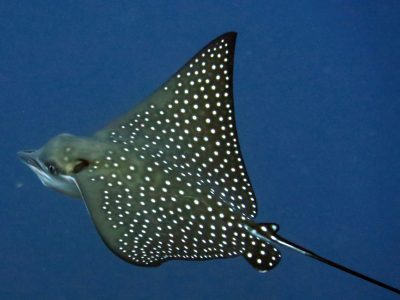
1st JAN - Spotted Eagle Ray (Aetobatus narinari)
This ray can be identified by its dark dorsal surface covered in white spots or rings. Near the base of the ray's relatively long tail, just behind the pelvic fins, are several venomous, barbed stingers. Spotted eagle rays commonly feed on small fish and crustaceans, and will sometimes dig with their snouts to look for food buried in the sand of the sea bed.
These rays are commonly observed leaping out of the water, and on at least two occasions have been reported as having jumped into boats, in one incident resulting in the death of a woman in the Florida Keys.
The spotted eagle ray is hunted by a wide variety of sharks. The rays are considered near threatened on the IUCN Red List. They are fished mainly in Southeast Asia and Africa, the most common market being in commercial trade and aquariums. They are protected in the Great Barrier Reef.
WHERE FOUND on wreck:
Top 10 metres on the wreck, generally around the two super structures. If there is current you are more likely to see them.
TIME OF YEAR SEEN:
Dec - March in schools of up to 20. However the odd one or two are seen throughout the year.
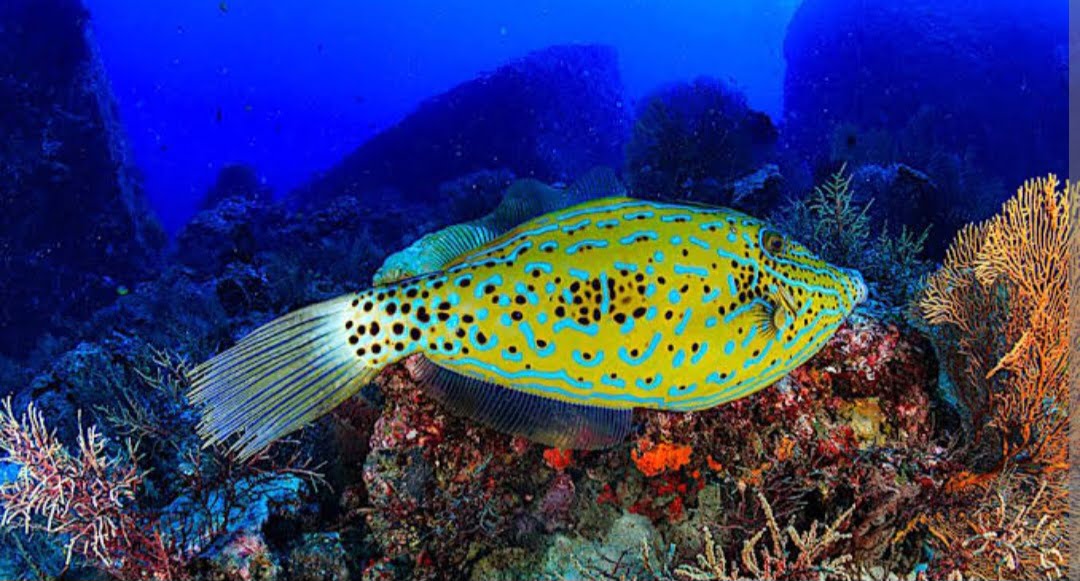
2nd JAN - The Scribbled Filefish (Aluterus scriptus)
The Scribbled Filefish is named for its array of striking colours and patterning along the slender, elongated and compressed body. This species is a marine fish that is well known for their ability to rapidly change colour to suit the environment they are in, often showing off their stunning illuminous markings.
This species can be found within both coral and rocky reefs within tropical waters from the Atlantic Ocean. The Scribbled Filefish are omnivorous grazers with a varied diet. These guys can feed on algea, phytoplankton, seagrass, different corals and even jellyfish.
The Scribbled Filefish can be spotted all over the ex-HMAS Brisbane, so be sure to keep an eye out for them.
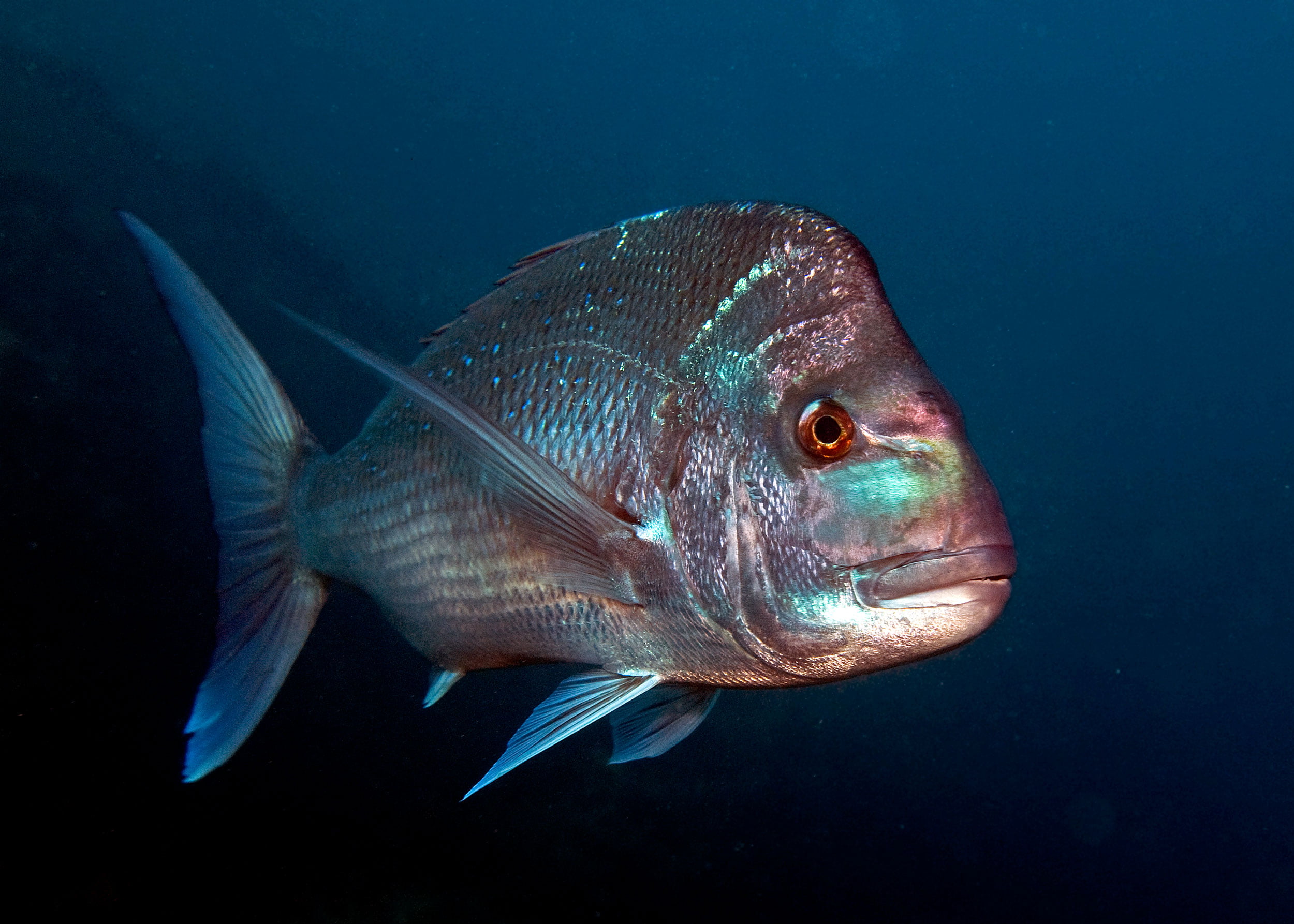
3rd JAN - SNapper (Chrysophrys auratus)
Snapper are usually pinkish to brown on the upper sides and silvery below. The body is covered by small blue spots that are most obvious in small fish.
Young snapper usually live in estuaries, while adults live in offshore rocky areas and reefs of up to 200 m deep. They school, and will migrate between reefs. Larger fish are known to enter estuaries and harbours
Snapper are carnivores and spend most time swimming close to the sea bed. They eat a widely varied diet, including fish, crustaceans, worms, molluscs and jellyfish. Though snapper are near the top of the food chain, they may be prey for large fish like estuary cod, dolphins and sharks.
Snapper also have a lifespan between 40 - 50 years!
WHERE FOUND on wreck: Anywhere between 15m - 5m on the front and rear stacks.
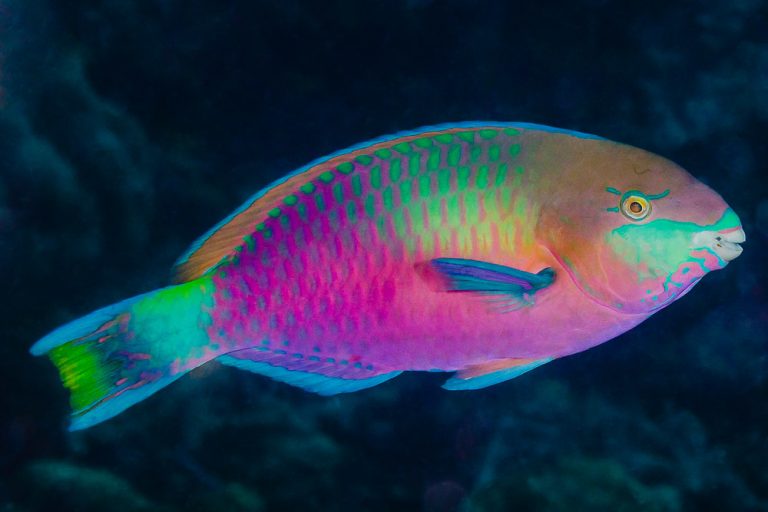
4th Jan - Palenose Parrotfish, (Scarus psittacus)
Parrotfish are close relatives of the wrasse, often forming large mixed schools with other species. While divers might struggle to spot a tiny cleaner wrasse, they’re unlikely to miss their bigger, brighter cousins. Some species of parrotfish can reach up to 1.2m in length.
There’s its diet, which consists primarily of algae extracted from chunks of coral ripped from a reef. The coral is pulverized with grinding teeth in the fishes’ throats in order to get to the algae-filled polyps inside. Much of the sand in the parrotfish's range is actually the ground-up, undigested coral they excrete.
Scientists estimate that a single large parrotfish has the ability to expel hundreds of pounds of sand a year ( Yep, you read that correct.. they poop sand!)
Finally, there are the pajamas. Every night, certain species of parrotfish envelope themselves in a transparent cocoon made of mucous secreted from an organ on their head. Scientists think the cocoon masks their scent, making them harder for nocturnal predators
WHERE FOUND on wreck: Anywhere along the Wreck, often spotted on the Bow munching away at alge on corals
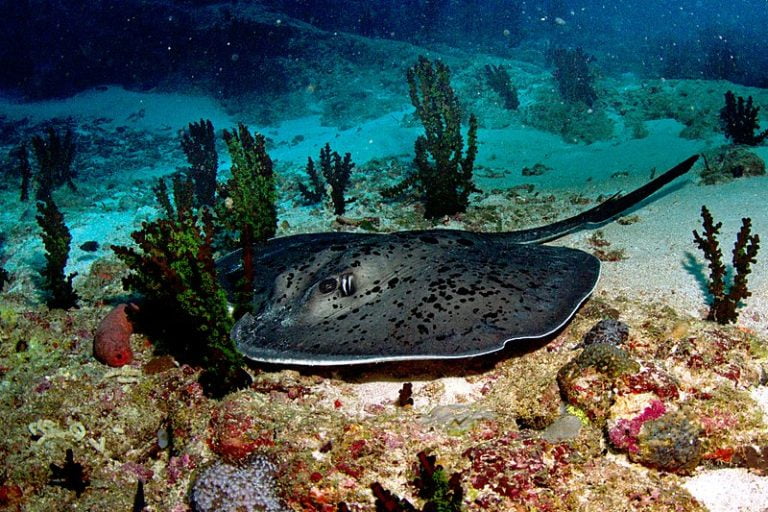
5th Jan - Blotched fantail Ray (Taeniura meyeni)
The Blotched Fantail Ray has a distinctive disc shape, color pattern and a ventral skin fold on its tail.
The Blotched Fantail Ray is commonly confused with another bull ray, the Cowtail Stingray. The difference being the colouration and the Cowtail Stingrays slightly pointed disc shape The Blotched Fantail Ray is a bottom dwelling species that can be found in inshore and coral reef waters usually on sandy substrates.
The maximum reported length of this large stingray is 3.3m total length (TL) and the maximum reported weight is 150kg. The maximum disc width is 1.8m DW which correlates to approximately 3.3m
This species is generally not aggressive and has been known to swim under divers on the wreck.
WHERE FOUND on wreck: Usually barrowed in the sand or swimming around the Port or Starboard side in the 20 - 27m mark.
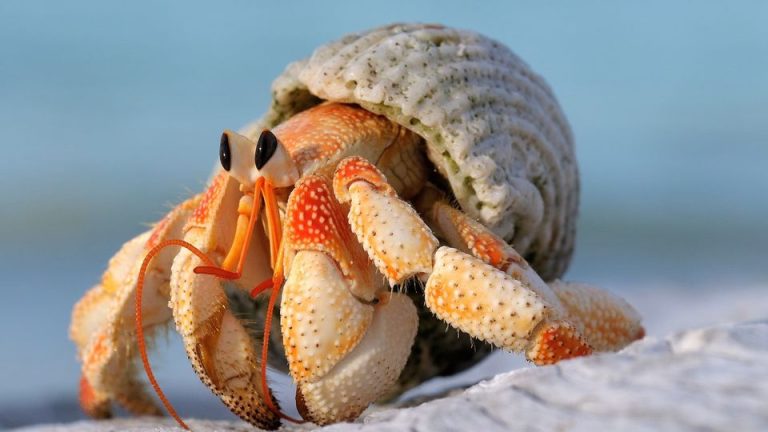
6th Jan - Hermit Crab (Paguroidea)
There are over 800 species of hermit crabs worldwide, with almost all of them being ocean dwellers.
Hermit crabs are small crustaceans with a soft abdomen protected by a borrowed shell, which they use as their mobile home. This shell also accommodates their growth as they molt and require larger shells.
The size of hermit crabs can depend on factors such as the availability of suitable shells and the abundance of gastropods, which provide the shells for the hermit crabs.
Hermit crabs communicate by chirping, producing soft high-pitched sounds that resemble a small frog. Chirping can indicate a territorial dispute or startle response.
Despite their name, hermit crabs are not solitary creatures. They often live in groups of 100 or more and can even collaborate in teams to find food. These fascinating crustaceans are more closely related to squat lobsters than true crabs.
WHERE FOUND on wreck: Anywhere along the deck, they mostly come out at night/dusk
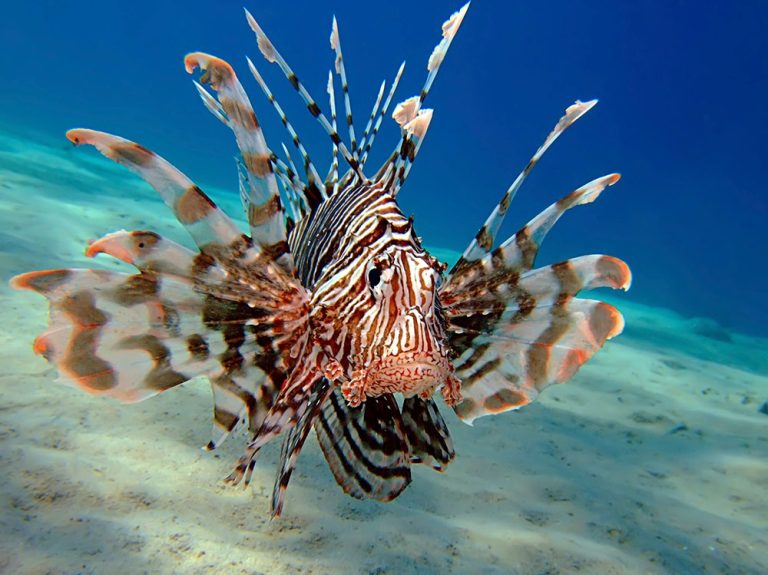
7th Jan - lion fish (pterois)
The lionfish is a visually captivating creature, with its flamboyant fins, intricate patterns, and vibrant colors that make it stand out in any underwater setting. The vibrant colors and intricate patterns serve as a form of warning coloration, indicating to potential predators that they are venomous and should be avoided.
WHERE FOUND on the wreck: Under the stern, around the bow either on the sand or at mid-water, and occasionally hiding around dark corners inside the wreck.
The lionfish is renowned for its impressive array of venomous spikes. These spines, found on its dorsal, pelvic, and anal fins, serve as a formidable defense mechanism. Each spike is encased in a protective sheath, housing venom-producing glands that can inflict painful stings upon contact. The spines are sharp and rigid, acting as a warning to potential predators, effectively deterring them from attacking. With their striking appearance and venomous arsenal, the lionfish's spikes are a powerful adaptation that ensures its survival in the vast depths of the ocean.
WHERE FOUND on the wreck: Mainly found inside the stern, however can been seen on the deck
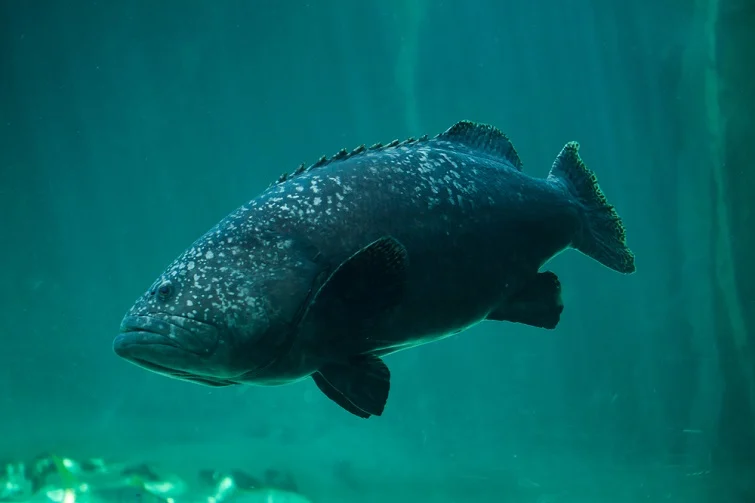
8th Jan - GIANT QUEENSLAND GROUPER (Epinephelus lanceolatus)
The Giant Queensland Grouper holds the title for the biggest reef-dwelling bony fish globally, found in tropical waters of the Indo-West Pacific and Australia's warm temperate coasts.
Some of them are massive, using powerful suction to inhale small prey when they feed.
These groupers can grow up to 3 meters and weigh around 600 kg, with males reaching maturity at about 1.3 meters. Juveniles have distinct blotched and banded patterns, but as adults, they become mottled and dark for effective camouflage during ambush hunting, often staying still or hovering using tiny fin movements.
They rely on estuaries, coral reefs, and associated habitats for survival. Giant Queensland Groupers, being large-mouthed ambush hunters, consume various fishes, small sharks, juvenile sea turtles, crustaceans, and mollusks, swallowing them whole.
Typically solitary and long-lived, these groupers become shyer as they grow larger. Despite their shyness, they may approach divers out of curiosity. Although not considered dangerous, caution is advised around their powerful mouth suction, divers be prepared to lose a mask!
WHERE FOUND on the wreck: Under the stern, around the bow on the sand and at mid-water, and occasionally will surprise you as you enter a new room inside the wreck.
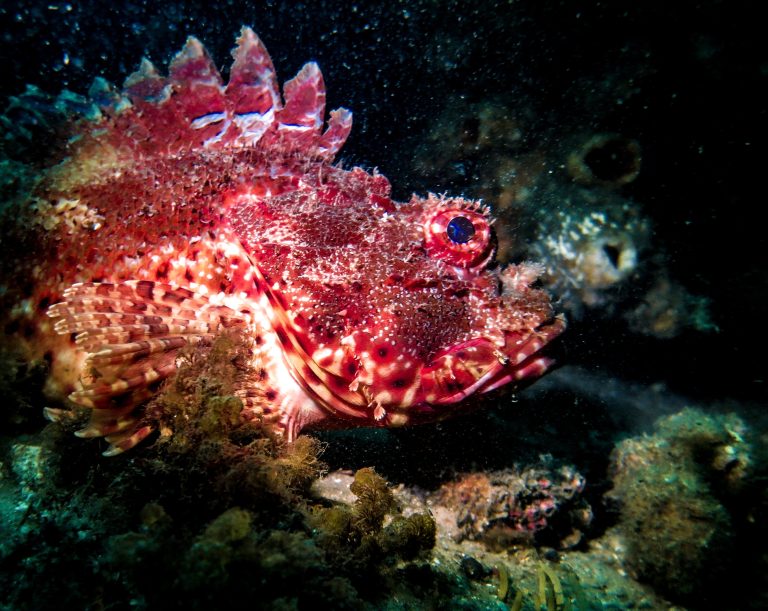
9th Jan - EASTERN RED SCORPIONFISH (Scorpaena jacksoniensis)
This species goes by many names including the Coral Cod, Red Rock Cod or Prickly Heat, however is more commonly known as the Eastern Red Scorpionfish. This species can be found within the coastal waters and rocky areas along our South- Eastern Coastline of Australia - in high abundance in Southern Queensland, NSW and Victoria.
Many scorpionfishes have cryptic colouration. This is is an advantage for predatory fishes like the Red Rockcod that often lie motionless on the bottom. Although the Eastern Red Scorpionfish is often bright red, its colouration is highly variable, ranging from light grey to bright red with blotches. The chest usually has small dark spots.There are skin flaps on the head, lateral line and other parts of the body. These help to disguise the shape of the fish.
The Eastern Red Scorpionfish is a predatory fish that lies motionless waiting for passing prey. This species can be described as an opportunistic feeder, primarily feeding on small fish and crustaceans, however are capable of eating anything as large as themselves.
This species has a pretty neat defence mechanism to predators, having the ability to spike them with their venomous spines on their dorsal fin. So, if you spot this species, be sure not to get too close as these spines contain an extremely painful toxin that can cause harm.
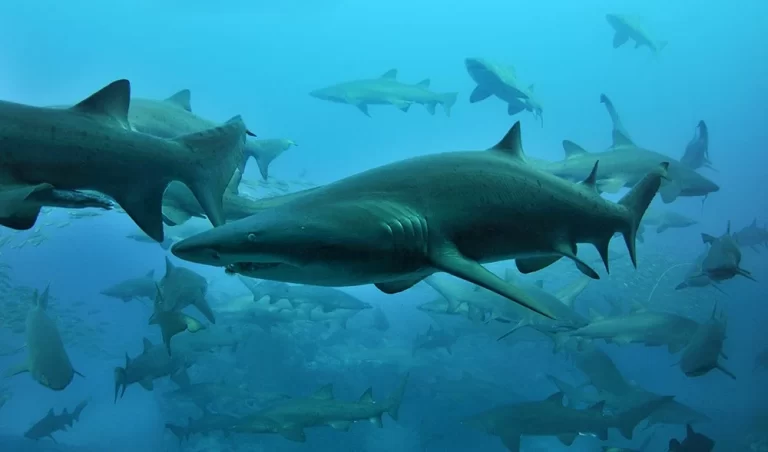
10th Jan - Grey Nurse Shark (Carcharias taurus)
Whilst uncommon to see, we have had a stint of Grey Nurse Shark sightings on the wreck this winter. Despite their fierce appearance, fear not - the Grey Nurse shark (aka sand tiger shark), is harmless to people. This species became the first protected shark in the world, when the NSW government declared it protected in 1984.
WHERE FOUND ON THE WRECK: We see Grey Nurse Sharks on the wreck once or twice a year. When seen they can be found swimming outside, generally below 18m.
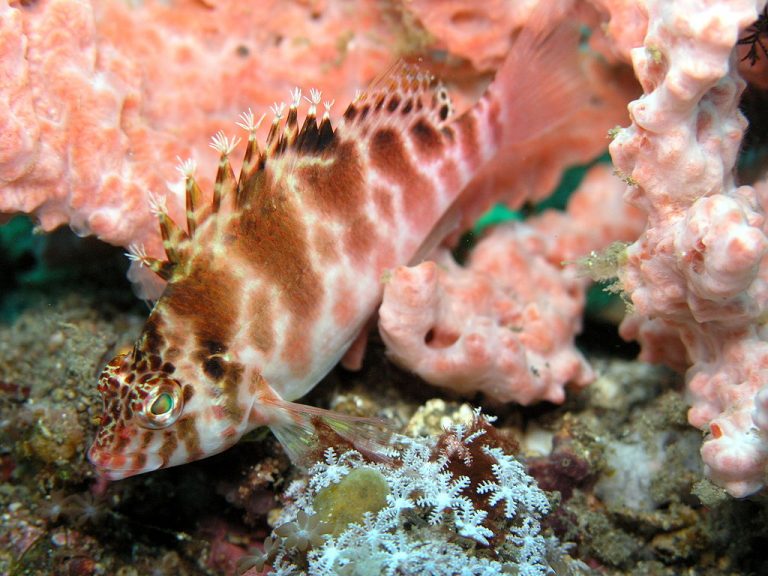
11th Jan - SPOTTED HAWKFISH (Cirrhitichthys aprinus)
The Hawkfish use their robust lower pectoral-fin rays to wedge into position where they will be subjected to the forces of currents and waves. They are carnivorous fishes, their main prey being benthic crustaceans. Hawkfish frequently sit and wait on the higher parts of their habitat, diving onto prey items seen underneath them, in a similar manner to some hawk species, hence the name Hawkfish.
The spotted hawkfish has a body in which the standard length is around two and a half times its depth. They have a strongly serrated preoperculum and a body which is covered in cycloid scales. The dorsal fin has 10 spines and 12 soft rays while the anal fin has 3 spines and 6 soft rays. The dorsal spines are tipped with short white filaments.
Look at them up close, they are quite pretty.
WHERE FOUND (on the wreck) - Generally anywhere on the outside of the ship. If you started counting them, you would find at least 40+ in one dive.
TIME OF YEAR SEEN: All year round
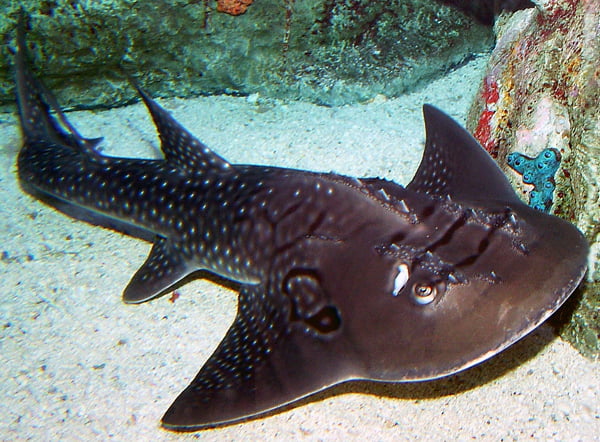
12th jan - bow mouth shark ray (rhina ancylostoma)
The Bow Mouth Shark Ray (also known as a Guitarfish) is a unique and critically endangered species with a cross between shark and ray characteristics. Its front body is flattened and wide, while the rest of its body and the large dorsal fins create a shark-like appearance. It has a broadly rounded snout with spiky thorns on the bony ridges above both eyes and along the back and shoulders. The tail is longer than the body and the pectoral fins are large with a broad base typical of a ray. Adult coloration is grayish-brown with white spots on the dorsal fins and darker spots on the head and shoulders.
Adult Bow Mouth Rays reach approximately 9.8 feet (3 meters) in length and have a maximum weight of about 135kg. These creatures are generally non-aggressive and tend to avoid human interaction. Their diet primarily consists of benthic crustaceans and mollusks.
WHERE FOUND on the wreck: Anywhere around the ship on the sand (very rare to see)

13th jan - yellowtail kingfish (Seriola lalandi)
The yellowtail kingfish (also known as amberjack, yellowtail kingfish, hiramasa or great amberjack) is a large fish found in the Southern Ocean. Very little is known of yellowtail kingfish biology, including its habitat preferences throughout juvenile life stages, migration patterns, and wild reproductive behaviour. Adults live around rocky reefs, rocky outcrops, and drop-offs in coastal waters, and around pinnacles and offshore islands. Their maximum length is often reported to reach up to 180 cm. Yellowtail kingfish are known for their curiosity around boats. The fish often accompany stingrays in harbours and estuaries, making use of the stingrays ability to sense fish through electroreception. Being a pelagic fish, yellowtail kingfish are highly active predators, usually in schools or in pairs. Their main diet consists of baitfish including yellowtail mackerel, squid, prawns, garfish, and kahawai. WHERE FOUND - Generally outside the ship in the open
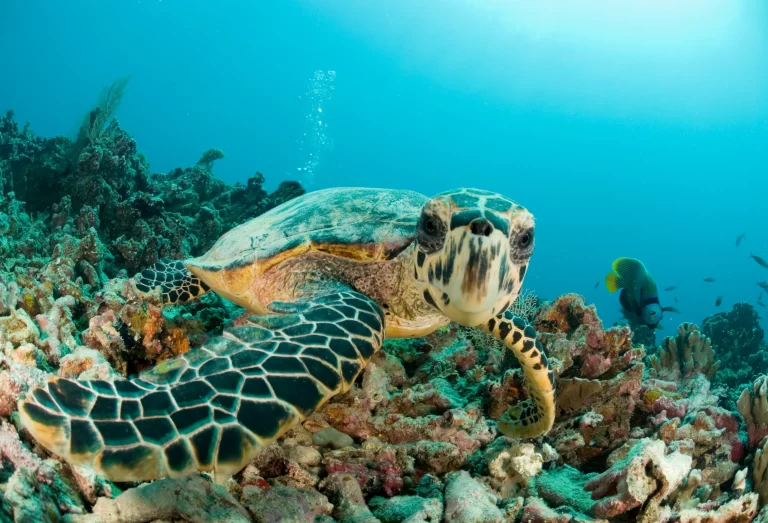
14th jan - Hawksbill turtle (Eretmochelys imbricata)
The Hawksbill has a flattened body shape, a protective carapace, a flipper-like limbs, adapted for swimming in the open ocean. E. imbricata is easily distinguished from other sea turtles by it's shape, curving beak with prominent tomium, and the saw-like appearance of its shell margins.
Hawksbill Turtles face several threats, including habitat loss due to coastal development and rising temperatures associated with global climate change, which is killing the coral reefs they rely on for food. They are also threatened by accidental capture in fishing nets.
These turtles have a specialized diet and feed mainly on sponges by using their narrow pointed beaks to extract them from crevices on the reef. They also eat sea anemones and jellyfish. They are able to feast on sponges that are toxic to other animals.
WHERE FOUND (on wreck) - There were two resident Hawksbill turtles from 2014 - 2017, however now we only see them from time to time. They are generally found on the outside of the ship, but they do venture inside every now and then.
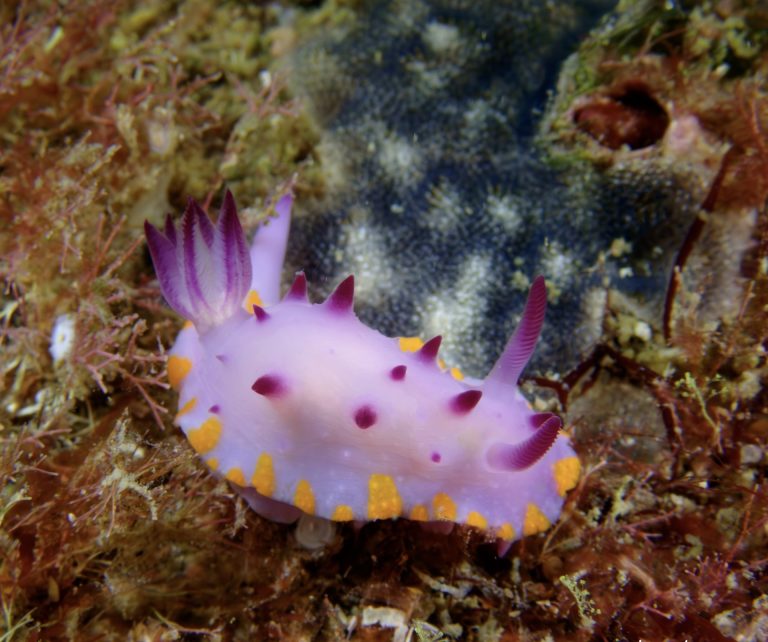
15th jan - NUDIBRANCH (mexichromis macropus)
The Mexichromis Macropus (commonly known as a nudibranch) is found throughout temperate and subtropical Australia. It differs from other species of nudibranchs with its mantle border of radially arranged orange or yellow-orange stripes (rather than spots of longitudinal lines. It is often found with a bluish grey sponge. It can grow up to 4cm
Where found (on wreck): Quite rare, but generally on the outside of ship
Photo credit: Sheryl Wright
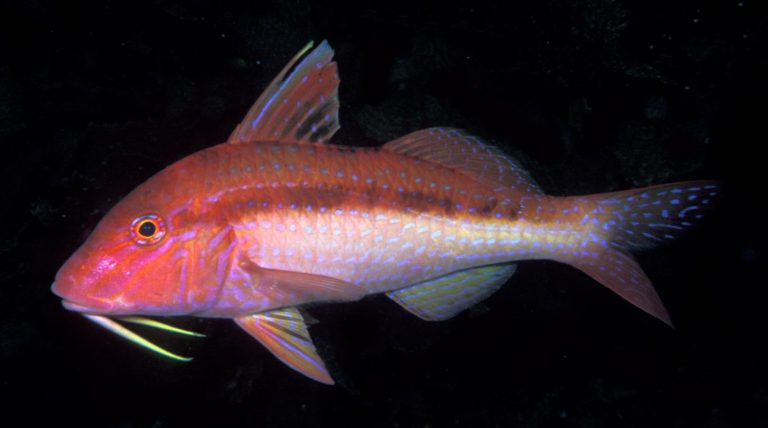
16th jan - Goatfish (Upeneus australiae)
Goatfish are characterized by two chin barbels (or goatee), which contain chemosensory organs and are used to probe the sand or holes in the reef for food. Their bodies are deep and elongated, with forked tails and widely separated dorsal fins
Bluestriped Goatfish vary greatly in color from almost white to a deep red, with an orange to reddish-brown stripe and lines of blue dots along the sides, and often other blotches and markings.
Goatfish use their sensory chin barbels to probe the sediment on search of prey.
WHERE FOUND - Bottom dwelling fish, often spotted on the Sand or around the Bow, Stern and Midships.
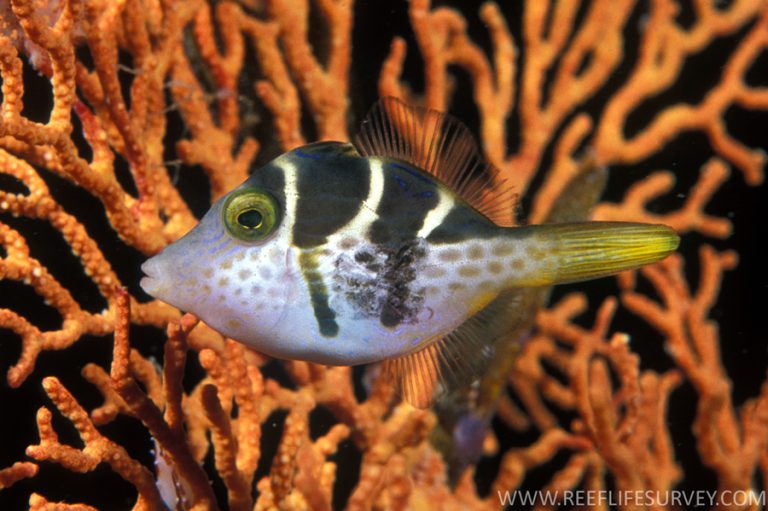
17th jan - Blacksaddle Filefish (Paraluteres prionurus)
The Blacksaddle Filefish is an highly adapted species of marine fish that can be found throughout the Tropical waters of the Indo-Pacific region, including within various reef ecosystems along our Eastern Coastline.
This remarkable species utilises Batesian mimicry to replicate the same colouration and shape of other toxic fish species, including the poisionsous Blacksaddle Toby. This is a survival advantage to avoid being eaten by predators. Pretty cool stuff!
WHERE FOUND: The Blacksaddle Filefish can be found hidden in and amongst the structures anywhere on the main deck of the wreck.

18th January - Sergeant Major Fish (Abudefduf saxatilis)
This species is apart of the Damnselfish family and is commonly referred to as the Sergeant Major. It has earnt this name due to the five black bars that cover its body- resembling the military services.
Watch out for the Sergeant Major Fish during breeding season, as this species is known to become more aggressive as it matures, and can form large feeding aggregations, sometimes containing several hundred individuals.
WHERE FOUND: Generally around the stacks in the wreck, and inside rooms at the back of the stacks.
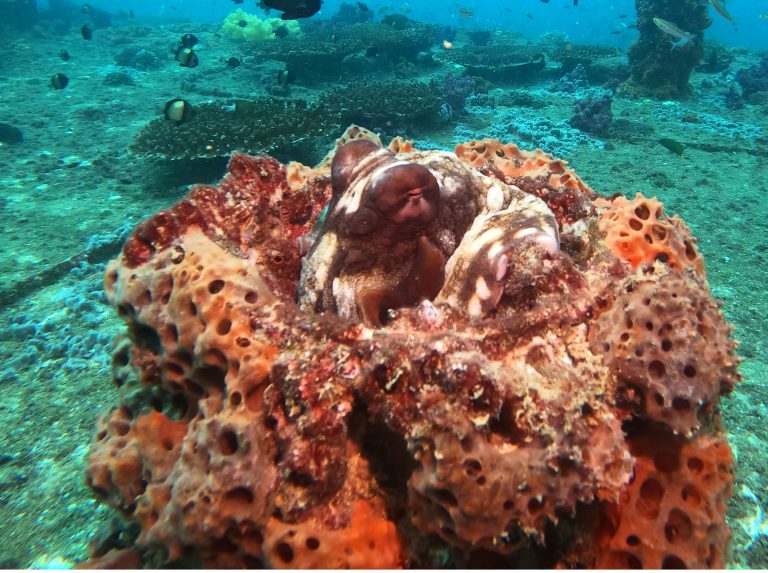
19th January - GLOOMY OCTOPUS (OCTOPUS TETRICUS)
The Gloomy Octopus, scientifically known as Octopus Tetricus, is truly a remarkable creature! These cephalopods, belonging to the mollusk family, are renowned for their large brains and a plethora of astonishing abilities. They exhibit exceptional cognitive skills, such as navigating mazes, problem-solving, memory retention, prediction, tool usage, and the ability to disassemble various objects, ranging from crabs to locks.
In 2009, the discovery of "Octopolis" in Jervis Bay unveiled a unique aspect of octopus behavior. This peculiar city hosts up to 10 octopuses simultaneously, engaging in communal living, communication, and even eviction of fellow inhabitants from their dens. A second city named ""Octlantis" was later found housing 23 octopus.
Remarkably, octopuses possess three hearts - two dedicated to pumping blood to the gills and a third responsible for circulating blood to vital organs. They showcase extraordinary regenerative abilities, capable of re-growing lost limbs. As a defense tactic, they can also detach an arm, allowing it to crawl independently.
Female octopuses play a significant role in reproduction, laying an astonishing number of eggs—up to 400,000 (200 egg strings). However, the mating process takes a dark turn for males, as females have been observed cannibalizing them after mating. The devoted female spends approximately five months guarding the eggs, exhibiting minimal eating and sleeping. Sadly, the female octopus meets its end shortly after the eggs hatch.
They are found along the eastern Australian coast from Lakes Entrance in Victoria to southern Queensland, including Lord Howe Island and New Zealand. Octopus tetricus typically displays a coloration ranging from grey to mottled brown. Their eyes are distinctive in their white color. The skin exhibits small irregular patches and large warty structures, creating a spiky appearance. They can have up to 260 suckers on each arm. Females are larger than males and can weigh up to 1kg. As primarily nocturnal feeders, they utilize their sharp beaks to prey on crustaceans and mollusks, showcasing their adaptability and prowess in the marine environment.
WHERE FOUND: Inside the anchor winch, and other hidey holes. At present there is one in the control room who has built a fortress with a knife sticking out to ward off predators.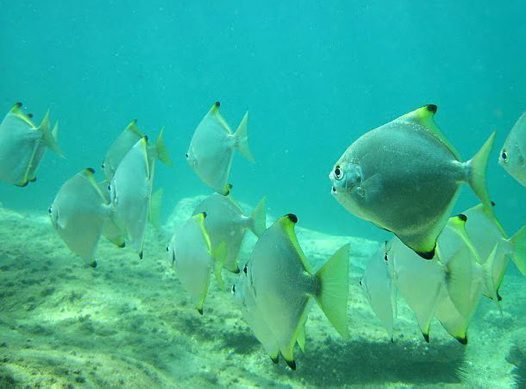
20th January - Diamond Fish (Monodactylus Argenteus)
The aptly-named Diamondfish is silvery with black to dusky leading edges and blackish fin tips on the dorsal and anal fins. Small juveniles have a yellow dorsal fin and two vertical bars on the head. (Other names: Butter Bream, Butter-Bream). These fish can reach a maximum length of about 27cm.
The diamondfish is native to the Western Pacific and Indian Oceans. This species is adaptable to various habitat types, including open ocean, brackish waters, and freshwater habitats of rivers.
WHERE FOUND on wreck: Can be found anywhere but predominantly around the 2 stacks
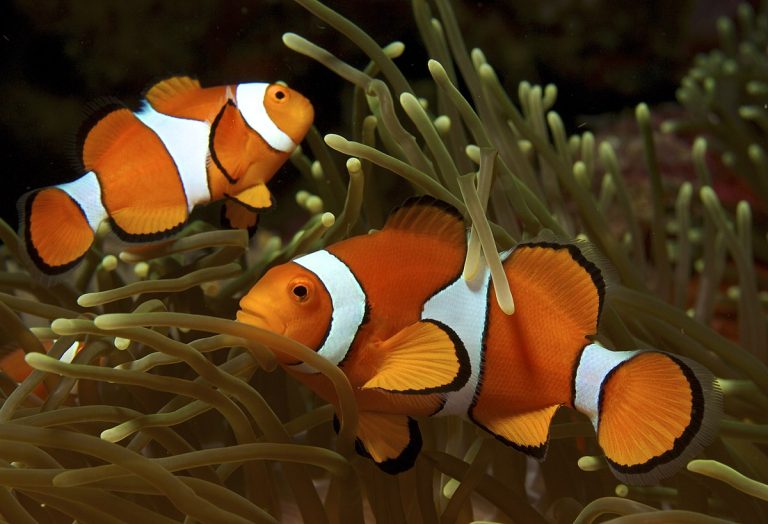
21st January - clown Fish (Amphiprioninae)
Clown Fish, with their vibrant orange bodies adorned with bold black and white stripes, gracefully navigate through the colorful coral reefs, bringing a touch of whimsy to the underwater world.
One of the most fascinating aspects of clown fish is their symbiotic relationship with sea anemones. They live in close proximity to these marine invertebrates and have a mutually beneficial partnership. The clown fish find protection among the tentacles of the anemone, while the anemone benefits from the clown fish's presence by gaining food scraps and protection from predators.
Clown fish have developed unique adaptations to thrive in their environment. They have a thin layer of mucus covering their bodies, which protects them from the stinging cells of the sea anemone. This mucus prevents them from being harmed by their host
There are several species of clown fish, including the popular orange clownfish and the clown anemonefish. While they share similarities, there are subtle differences between them. For example, the orange clownfish has thick black bands separating the orange and white coloration of its body, while the clown anemonefish has thin black bands. The orange clownfish also has a pronounced bulging face, giving it a frog-like appearance
WHERE FOUND on the wreck: There's only a couple that live on the wreck, the main one is just in front of the control room, and there are a couple on the bow.
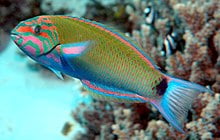
22nd January - Moon Wrasse (Thalassoma Lunare)
The moon wrasse also known as the crescent wrasse or lyretail wrasse, is a species of wrasse native to the Indian Ocean and the western Pacific Ocean. It is an inhabitant of coral reefs and surrounding areas at depths from 1 to 20 m . Moon wrasses are carnivorous and tend to prey on fish eggs and small sea-floor dwelling invertebrates. They can reach 45 cm in total length. It is of minor importance to local commercial fisheries and can also be found in the aquarium trade. The juvenile is blue on the lower half of its body, with a black spot in the middle of the dorsal fin and a black blotch on the caudal fin base. As it matures, the spot turns into a yellow crescent, hence the name. The body is green, with prominently marked scales. Coloration of the head ranges from blue to magenta, with a broken checkerboard pattern. Moon wrasses are active fish, said to be moving all day long. They are also territorial, nipping, chasing, and otherwise harassing fish that get in their way. Being diurnal, wrasses have strong vision. They also have a decent sense of smell. At night, they rest in niches often under rocks or other such structures. If needed, a moon wrasse may dig out space under a rock by repeatedly swimming through it until it fits without struggle. WHERE FOUND on the wreck and on the Mooloolaba Reefs.
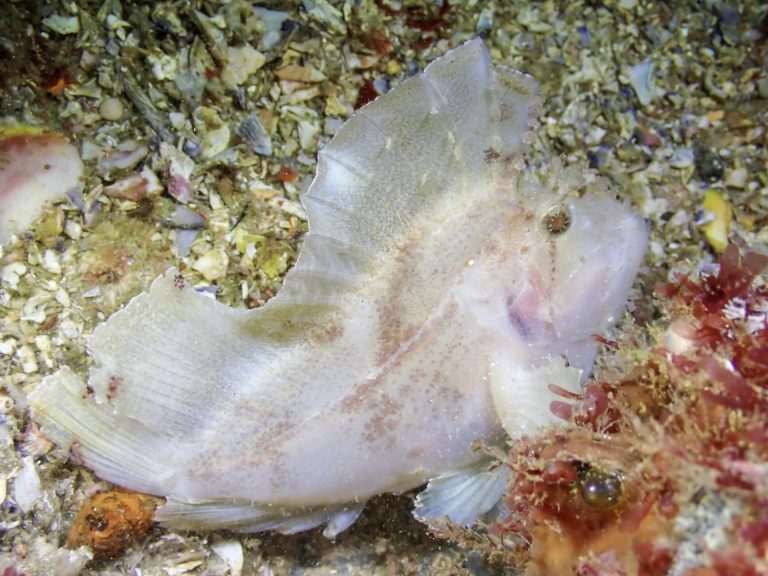
23RD January - Leaf Scorpion fisH (Taenianotus triacanthus)
The Leaf Scorpion fish is about 10 cm long fully grown. Their color varies from green, red, pink, brown, ocher and yellowish to a ghostly white.
The Leaf Scorpion fish resembles a dead leaf lying in the water. To enhance this camouflage, it even makes gentle sideways movements in its pelvic area which make it resemble a drifting inert object. It is an ambush predator, waiting until suitable prey, a small fish or shrimp, approaches.
The venom of the leaf scorpionfish is considerably weaker than that of the lionfish and stonefish. However if a diver is stung, it will deliver a very painful venom.
WHERE FOUND (on the wreck): Can be in the sand or anywhere on the ship - these are very rare. If you get a photo of one in February on the HMAS Brisbane you will receive $50 store credit.
Photo credit: Sheryl Wright (Sept 2023)
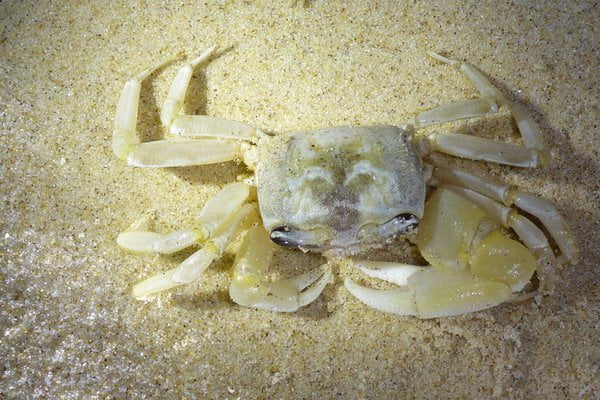
24th January - Decorator Crab (Naxia tumida)
The Decorator Crab is also known as the Seaweed Crab. The Decorator Crab's carapace is covered with hooks to attach algae, seaweed or anything in the environment that will assist in camouflage. It lives on intertidal rocky shores and is found in the temperate waters of Australia in Queensland, New South Wales, Victoria, Tasmania and Western Australia. WHERE FOUND: During night dives on the deck of the ex-HMAS Brisbane
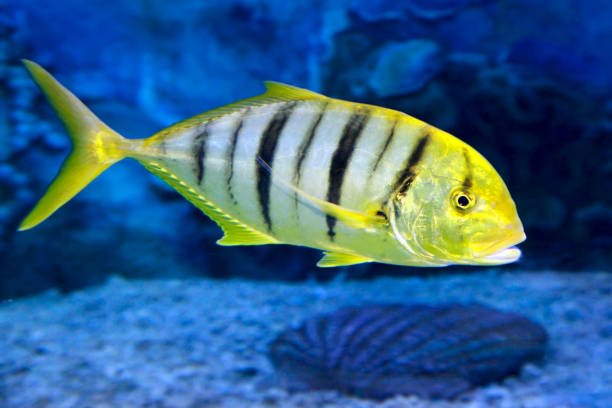
25th January - Golden TRevally (Gnathanodon speciosus)
The Round Bat Fish, scientifically known as Platax orbicularis, is a captivating species of fish found in the warm tropical waters of the Indo-Pacific region. Its name is derived from its unique round shape, resembling that of a disc. This fascinating creature stands out with its striking colors, varying from yellow to silver, and its eye-catching patterns that adorn its body. One of the most notable features of the Round Bat Fish is its bat-like pectoral fins, which give it a distinct appearance as it gracefully glides through the water. These fins are used not only for propulsion but also for maneuvering and stability. It is a social species, often seen in small groups, and is known to be relatively docile and non-aggressive. The Round Bat Fish is an herbivorous fish, feeding on various types of algae and small invertebrates. Its diet contributes to the balance of marine ecosystems, making it an important species in the underwater world. With its unique characteristics and behavior, the Round Bat Fish is a true marvel of nature and a delight for divers and underwater enthusiasts lucky enough to encounter it in its natural habitat. WHERE FOUND: On the ex-HMAS Brisbane and the Mooloolaba Reefs
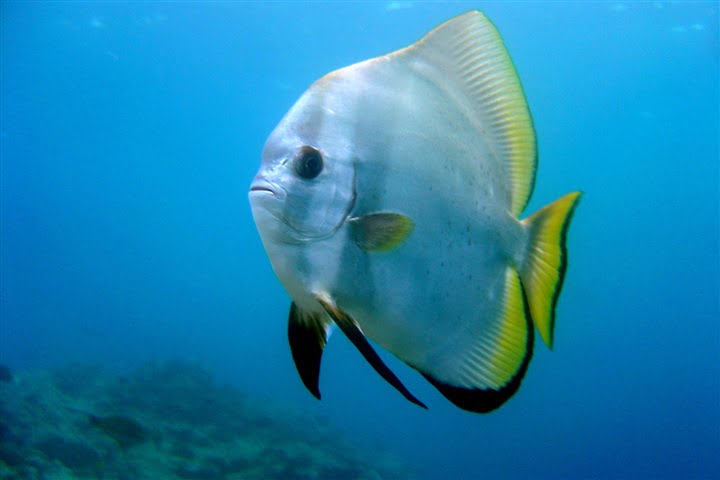
26th January - round bat fish (Platax Orbicularis)
The Round Bat Fish, scientifically known as Platax orbicularis, is a captivating species of fish found in the warm tropical waters of the Indo-Pacific region. Its name is derived from its unique round shape, resembling that of a disc. This fascinating creature stands out with its striking colors, varying from yellow to silver, and its eye-catching patterns that adorn its body. One of the most notable features of the Round Bat Fish is its bat-like pectoral fins, which give it a distinct appearance as it gracefully glides through the water. These fins are used not only for propulsion but also for maneuvering and stability. It is a social species, often seen in small groups, and is known to be relatively docile and non-aggressive.
The Round Bat Fish is an herbivorous fish, feeding on various types of algae and small invertebrates. Its diet contributes to the balance of marine ecosystems, making it an important species in the underwater world. With its unique characteristics and behavior, the Round Bat Fish is a true marvel of nature and a delight for divers and underwater enthusiasts lucky enough to encounter it in its natural habitat.
WHERE FOUND: In the top 10 meters, usually seen at divers safety stops. However, they also come down to deck level when they need to be cleaned.
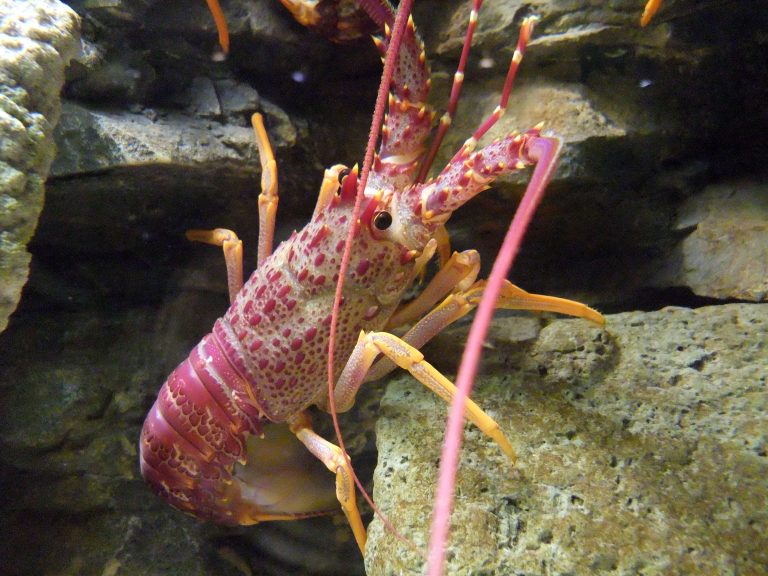
27th January - spiny lobster (Panulirus)
The spiny lobster is a crustacean that belongs to the family Palinuridae. Spiny lobsters get their name from the forward-pointing spines that cover their bodies, which help protect them from predators .
Unlike true lobsters, spiny lobsters do not have large claws. Instead, people primarily consume the abdomen of the spiny lobster, which is marketed as lobster tail . Spiny lobsters are found in various regions, including the Caribbean, California, and South Africa . They inhabit shallow waters and can be found in crevices and caves among rocks.
Spiny lobsters molt several times throughout their lives, growing larger with each molt. After molting, they are soft-bodied and vulnerable to predators until their new, larger exoskeleton forms over their growing body The larvae of spiny lobsters travel long distances as plankton in currents before settling in shallow water nursery habitats .
WHERE FOUND (on the wreck): Tucked away under something. Best spotted inside the wreck with a torch. Their antennas are usually the first thing people spot.
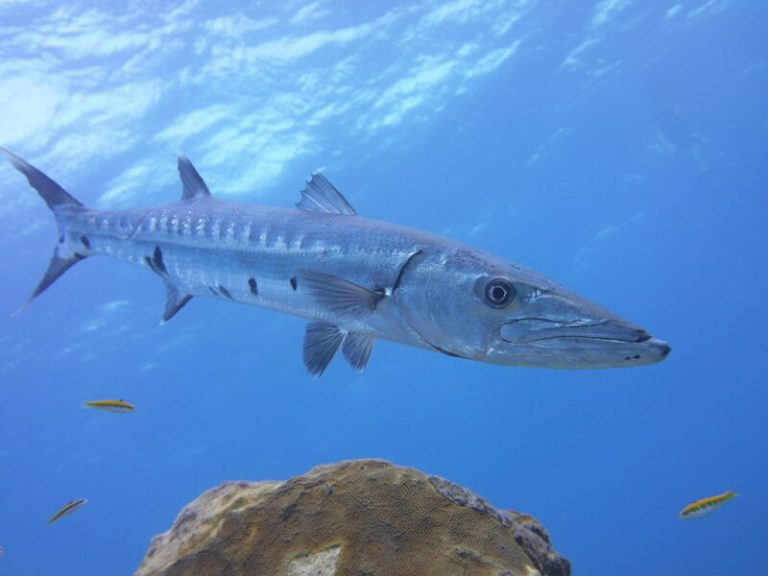
28th January - barracuda (Sphyraena)
A barracuda is a type of predatory fish found in warm and tropical regions, including coral reefs and tall sea grasses . There are over 20 species of barracudas, with the most well-known being the great barracuda . Barracudas have streamlined, torpedo-shaped bodies and are known for their incredible speed and agility . They have a large mouth filled with razor-sharp teeth, with the lower jaw jutting out past the upper jaw . The teeth are used for tearing and piercing the flesh of their prey . Barracudas vary in size, with the great barracuda reaching lengths of up to 1.2-1.8 meters (4-6 feet).
Barracudas are known for their hunting prowess. They are capable of incredible bursts of speed and have a menacing mouth full of needle-like teeth . They are opportunistic predators, feeding on a variety of prey including smaller fish and invertebrates Barracudas can even hunt fish almost as big as themselves, slicing them in two if they are too large to swallow in one gulp.
While barracudas are generally not a threat to humans, there have been instances where they have bitten swimmers, possibly mistaking them for prey Humans are typically more dangerous to barracudas, as they are popular as food . Barracudas mainly inhabit very warm, tropical waters near coral reefs and tall sea grasses .
WHERE FOUND (on the wreck): They are mainly around the top stack but also sometimes on the outer areas of the ship.
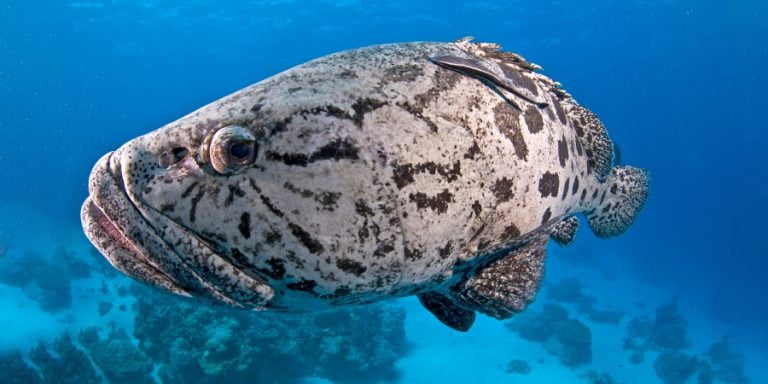
29th January - POTATO gROUPER (EPINEPHELUS TUKULA)
The potato cod is a diver's delight, known for its unique potato-like markings and friendly demeanour. These ambush predators feast on small rays, crabs, fish and lobsters. They hide from their prey using coral as cover & lunge when the prey is in range, swallowing their prey whole.
Living in tropical waters among coral reefs, they stick to the same area for years. They are easy targets for spear fishers overseas due to their familiarity with humans and that they reside in the same place for their whole lives. Fortunately, they are protected in Qld. These giants can reach 2 meters in length and weigh around 100 kg.
Interestingly, they start as females and change to males during their lives. When it's time to spawn, they gather in groups, traveling several kilometres to reach the spawning site, a significant journey for these usually sedentary creatures.
WHERE FOUND (on the wreck): They are mainly around the top stack but also sometimes on the outer areas of the ship.
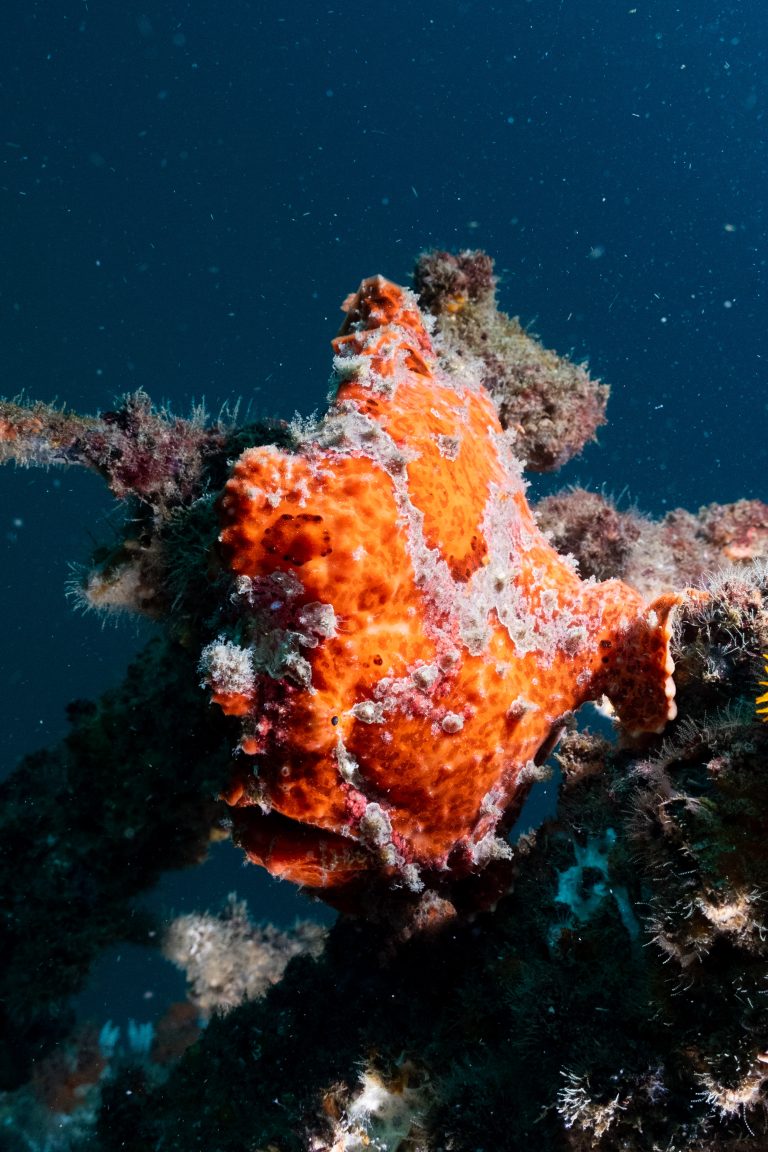
30th January - FROG Fish (Antennarius Commersonii)
Frog Fish (Antennarius commersonii) Also known as the giant angler, this frogfish lives in the tropical and subtropical waters from the Indian Ocean to the eastern coasts of the Pacific Ocean. It is found in lagoons and sheltered rocky and coral reefs. They are usually associated with big sponges, on underwater ropes, on jetty pillars, or any structures down to 70 m deep, with an averag occurrence at 20 m deep. Frogfishes are covered in spinules and other appendages to aid in camouflage. The camouflage aids in protection from predators and enables them to lure prey. Many species can change colour; some are covered with other organisms such as algae or hydrozoa. In keeping with this camouflage, frogfishes typically move slowly, lying in wait for prey, and then striking extremely rapidly, in as little as 6 milliseconds. WHERE FOUND: Only four or five reported sightings of one of these curious creatures since the wreck was sunk Photo credit: Mike McKinnon
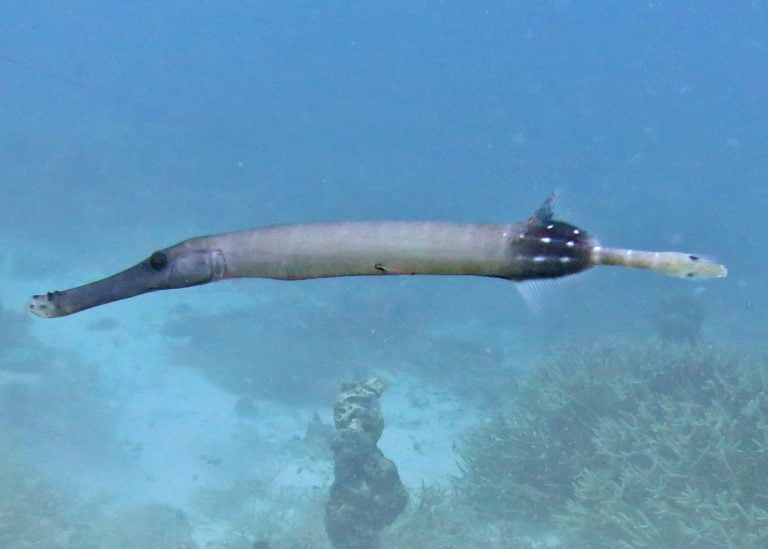
31 January - TrumpetFish (Aulostomus Chinenis)
The trumpetfishes are three species of highly specialized, tubularly-elongated marine fishes in the genus Aulostomus, The trumpetfishes are members of the order Syngnathiformes, together with the seahorses and the similarly built, closely related cornetfishes. The generic name, Aulostomus, is a composite of two Greek words: aulos, meaning flute, and stoma, meaning mouth, because the species appear to have tubular snouts. Trumpetfishes are found in tropical waters worldwide, with two species in the Atlantic and one in the Indo-Pacific. They are mostly demersal reef-dwellers, where one species seems to prefer rocky substrate. They are relatively large for reef fish, and can reach almost 1 m in length. Bodies of trumpetfish are elongated, rigid, and pike-shaped. Their dorsal and anal fins are closely adjacent to the tail, where individual dorsal spines reach midway towards the head region. The bodies of trumpetfish are inflexible, supported by interwoven struts of bone. A distinct trait of the family is their long, tubular snouts. They have the capability to expand their jaws quickly into a circular, gaping hole almost to the body's diameter when feeding. Aulostomids are highly carnivorous fish and feed almost exclusively on small, schooling reef fishes. WHERE FOUND: Can be found hiding inside the wreck